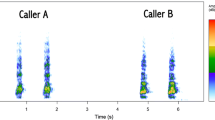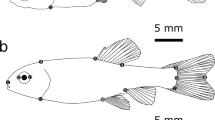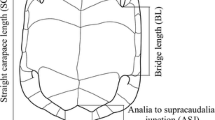Abstract
In many species, individuals suffer major mortality in their first year because of predation. Behaviours that facilitate successful escape are therefore under strong selection, but anti-predator skills often emerge gradually during an individual’s early development. Using long-term data and acoustic recordings of alarm calls collected during natural predator encounters, we aimed to elucidate two largely unsolved issues in anti-predator ontogeny: (1) whether incorrect predator assignment is adaptively age-appropriate, given that vulnerability often changes during development, or whether age-related differences reflect true mistakes made by immature individuals; and (2) the extent to which the development of adult-like competence in alarm-call production and usage is simply a function of maturational processes or dependent upon experience. We found that young meerkats (Suricata suricatta) were less likely to give alarm calls than adults, but alarmed more in response to non-threatening species compared to adults. However, stimuli that pose a greater threat to young than adults did not elicit more calling from young; this argues against age-related changes in vulnerability as the sole explanation for developmental changes in calling. Young in small groups, who were more likely to watch out for predators, alarmed more than less vigilant young in larger groups. Moreover, despite similarities in acoustic structure between alarm call types, calls appeared in the repertoire at different rates, and those that were associated with frequently encountered predators were produced relatively early on. These results indicate that experience is a more plausible explanation for such developmental trajectories than maturation.




Similar content being viewed by others
References
Altmann J (1974) Observational study of behaviour—sampling methods. Behaviour 49:227–267
Arenz CL, Leger DW (2000) Antipredator vigilance of juvenile and adult thirteen-lined ground squirrels and the role of nutritional need. Anim Behav 59:535–541
Boliek CA, Hixon TJ, Watson PJ, Morgan WJ (1996) Vocalization and breathing during the first year of life. J Voice 10:1–22
Clutton-Brock TH, Gaynor D, McIlrath GM, MacColl ADC, Kansky R, Chadwick P, Manser M, Skinner JD, Brotherton PNM (1999a) Predation, group size and mortality in a cooperative mongoose, Suricata suricatta. J Anim Ecol 68:672–683
Clutton-Brock TH, O’Riain MJ, Brotherton PNM, Gaynor D, Kansky R, Griffin AS, Manser M (1999b) Selfish sentinels in cooperative mammals. Science 284:1640–1644
Doolan SP, Macdonald DW (1997) Breeding and juvenile survival among slender-tailed meerkats (Suricata suricatta) in the south-western Kalahari: ecological and social influences. J Zool 242:309–327
Gaston AJ (1977) Social behavior within groups of jungle babblers (Turdoides striatus). Anim Behav 25:828–848
Griffin AS, Blumstein DT, Evans C (2000) Training captive-bred or translocated animals to avoid predators. Cons Biol 14:1317–1326
Hammerschmidt K, Freudenstein T, Jurgens U (2001) Vocal development in squirrel monkeys. Behaviour 138:1179–1204
Hauser MD (1988) How infant vervet monkeys learn to recognize starling alarm calls—the role of experience. Behaviour 105:187–201
Hollén LI, Manser MB (2006) Ontogeny of alarm call responses in meerkats (Suricata suricatta): the roles of age, sex and nearby conspecifics. Anim Behav 72:1345–1353
Hollén LI, Manser MB (2007) Motivation before meaning: motivational information encoded in meerkat alarm calls develops earlier than referential information. Am Nat 169:758–767
Klump GM, Shalter MD (1984) Acoustic behavior of birds and mammals in the predator context. 1. Factors affecting the structure of alarm signals. 2. The functional significance and evolution of alarm signals. Z Tierpsychol 66:189–226
Lieberman P (1986) The acquisition of intonation by infants: physiology and neural control. In: Lewis J (ed) Intonation in discourse. College-Hill Press, San Diego, CA, pp 239–257
Macedonia JM, Evans CS (1993) Variation among mammalian alarm call systems and the problem of meaning in animal signals. Ethology 93:177–197
Manser MB (1998) The evolution of auditory communication in suricates, Suricata suricatta. Ph.D. thesis, University of Cambridge
Manser MB (2001) The acoustic structure of suricates’ alarm calls varies with predator type and the level of response urgency. Proc R Soc Lond B Biol Sci 268:2315–2324
Mateo JM (1996a) The development of alarm-call response behaviour in free-living juvenile Belding’s ground squirrels. Anim Behav 52:489–505
Mateo JM (1996b) Early auditory experience and the ontogeny of alarm-call discrimination in Belding’s ground squirrels (Spermophilus beldingi). J Comp Psychol 110:115–124
Mateo JM, Holmes WG (1997) Development of alarm-call responses in Belding’s ground squirrels: the role of dams. Anim Behav 54:509–524
McCowan B, Franceschini NV, Vicino GA (2001) Age differences and developmental trends in alarm peep responses by squirrel monkeys (Saimiri sciureus). Am J Primatol 53:19–31
McNamara JM, Houston AI (1992) Evolutionarily stable levels of vigilance as a function of group size. Anim Behav 43:641–658
Pinheiro JC, Bates DM, DebRoy S, Sarkar D (2005) nlme: linear and nonlinear mixed effects models. R package version 3.1–66
Platzen D, Magrath RD (2005) Adaptive differences in response to two types of parental alarm call in altricial nestlings. Proc R Soc Lond B Biol Sci 272:1101–1106
R Development Core Team (2006) R: a language and environment for statistical computing. R Foundation for Statistical Computing, Vienna, Austria. http://www.R-project.org
Ramakrishnan U, Coss RG (2000) Age differences in the responses to adult and juvenile alarm calls by bonnet macaques (Macaca radiata). Ethology 106:131–144
Scheiner E, Hammerschmidt K, Jurgens U, Zwirner P (2002) Acoustic analyses of developmental changes and emotional expression in the preverbal vocalizations of infants. J Voice 16:509–529
Seyfarth RM, Cheney DL (1980) The ontogeny of vervet monkey alarm calling behavior—a preliminary report. Z Tierpsychol 54:37–56
Seyfarth RM, Cheney DL (1986) Vocal development in vervet monkeys. Anim Behav 34:1640–1658
Venables WN, Ripley BD (2002) Modern applied statistics with S. 4th edn. Springer, New York
Acknowledgement
We are grateful to the family of H. Kotze and the Northern Cape Conservation Service for allowing our work to be carried out on their land. We also thank Johan Du Toit and Martin Haupt at the Mammal Research Institute, University of Pretoria, for logistical support, and all students and volunteers who contributed with data collection for the long-term database. This manuscript benefited from the advice of Andrew Radford, Hansjoerg Kunc, Neil Jordan and two anonymous referees. The project was funded by a grant given to MBM from the Swiss National Science Foundations, SNF-Förderprofessur Nr 631-066129 and carried out under licences issued by the Northern Cape Conservation Service and the ethical committee of Pretoria University, South Africa.
Author information
Authors and Affiliations
Corresponding author
Additional information
Communicated by D. Watts
Rights and permissions
About this article
Cite this article
Hollén, L.I., Clutton-Brock, T. & Manser, M.B. Ontogenetic changes in alarm-call production and usage in meerkats (Suricata suricatta): adaptations or constraints?. Behav Ecol Sociobiol 62, 821–829 (2008). https://doi.org/10.1007/s00265-007-0508-x
Received:
Revised:
Accepted:
Published:
Issue Date:
DOI: https://doi.org/10.1007/s00265-007-0508-x




